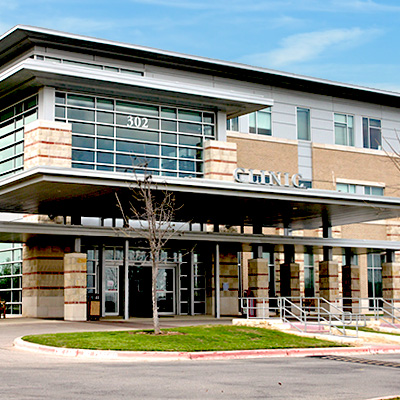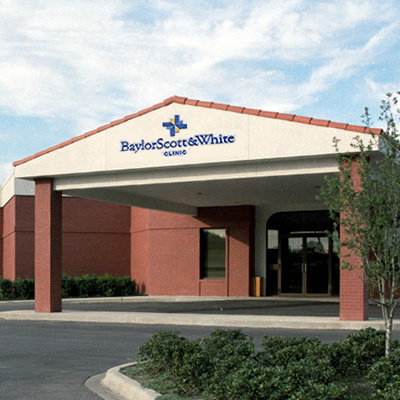What is in vitro fertilization (IVF)?
In vitro fertilization (IVF) is a medical procedure that helps women become pregnant by fertilizing eggs outside of the body and then implanting them into the uterus. It's a type of assisted reproductive technology (ART) that's often used when other fertility treatments have failed.
If you and your partner have experienced fertility problems, you may choose IVF to increase your chances of a successful pregnancy. At Baylor Scott & White, your dedicated team of fertility specialists will support you on your IVF journey.
Why is IVF performed?
People choose IVF for various reasons, such as infertility issues or existing health conditions in one partner. It’s often pursued after other fertility methods have failed or for those of advanced maternal age. IVF is also a viable reproductive option for same-sex couples or people seeking to have a baby without a partner.
IVF may be an option if you or your partner has:
- Blocked or damaged fallopian tubes
- Endometriosis
- Low sperm count or other sperm issues
- Polycystic ovary syndrome (PCOS) or other ovarian conditions
- Uterine fibroids
- Uterine abnormalities
- A risk of passing on a genetic disease or disorder
- Unexplained infertility
- Lack of success with other fertility treatments
- Plans to use an egg donor or gestational carrier
How to prepare for IVF
Before starting IVF treatment, you'll go through a comprehensive medical exam and fertility tests, and your partner will be assessed as well. Here are the potential steps you can expect during the preparation:
- IVF consultation: Discuss the IVF process with your healthcare team.
- Uterine exam: Includes an updated Pap test and mammogram if you're over 40.
- Semen analysis: Testing of your partner's sperm.
- Infection screening: Tests for sexually transmitted infections (STIs) and other conditions.
- Ovarian reserve and other hormone testing: Along with blood and urine tests.
- Fertility medication instructions: Guidance on how to administer medications.
- Genetic carrier screening: To identify any potential genetic issues.
- Consent forms: Signing necessary documents.
- Uterine cavity evaluation: Conducted through hysteroscopy or saline-infused sonography (SIS).
Additionally, your healthcare provider will recommend starting folic acid supplements or other vitamins before the IVF cycle and embryo transfer.
You may also want to prepare yourself emotionally. IVF can be a stressful experience with lots of uncertainty. Talk to your infertility specialist and ensure you completely understand the process and decisions you and your partner may need to make at each step. Also, find ways to spend quality time as a couple when you can focus on your relationship and not the IVF process.
The IVF process
IVF is a complex process that involves retrieving eggs from ovaries and manually combining them with sperm in a lab for fertilization. The main steps for in vitro fertilization include:
Ovarian stimulation
In a natural reproductive cycle, a group of eggs start to mature during each month, but usually, only one egg fully matures for ovulation, while the rest disintegrate.
During IVF, hormone injections stimulate the eggs in that cycle's group to mature at the same time, potentially yielding multiple eggs for retrieval. The medication type, dosage and frequency are personalized based on factors like your medical history, age, Anti-Müllerian Hormone (AMH) level and prior response to IVF.
Ovarian stimulation involves:
- Monitoring: Ultrasounds and blood tests track how your ovaries respond to the hormones. Monitoring happens frequently, over 8 to 14 days. While individual eggs aren’t visible, your healthcare team will measure ovarian follicles, which each hold a potential egg. Follicles larger than 14 mm generally contain mature eggs ready for retrieval.
- Trigger Shot: Once your eggs are mature, a "trigger shot" is given 34 to 36 hours before retrieval to finalize maturation, preparing the eggs for collection.
Egg retrieval
While under anesthesia, your healthcare provider inserts a thin needle through the vagina into each ovary using ultrasound guidance. The needle, connected to a suction device, gently extracts eggs from each follicle.
The retrieved eggs are placed in a dish with a special solution and then transferred to an incubator for optimal conditions.
To minimize discomfort, medication and mild sedation are provided during the procedure. Egg retrieval typically occurs 34 to 36 hours after your final hormone injection, known as the "trigger shot."
Fertilization and embryo development
There are two common methods used to fertilize eggs with sperm:
- Conventional insemination: Healthy sperm and mature eggs are mixed and placed in an incubator.
- Intracytoplasmic sperm injection (ICSI): A single sperm is injected directly into each mature egg. ICSI is typically used when there are sperm quality issues or when fertilization failed in previous IVF attempts.
In some cases, additional procedures may be recommended before embryo transfer:
- Assisted hatching: About 5 to 6 days after fertilization, an embryo hatches from its surrounding membrane to attach to the uterus. If you're older or have had unsuccessful IVF attempts, assisted hatching can help. A small hole is made in the embryo's membrane to aid this process, especially for frozen embryos, which may have a hardened membrane.
- Preimplantation genetic testing: Embryos are allowed to develop until a small sample can be taken and tested for genetic diseases or chromosome abnormalities. Embryos free of issues can be transferred to the uterus. This test reduces—but doesn't eliminate—the risk of passing on genetic conditions, so prenatal testing is still recommended during pregnancy.
Typically, about 70% of mature eggs fertilize. For example, if 10 mature eggs are retrieved, around seven will fertilize and potentially become embryos. If there’s a large number of eggs or you wish to save some for later, unfertilized eggs can be frozen.
Over the next five to six days, embryo development is closely monitored. About 50% of fertilized eggs reach the blastocyst stage, which is optimal for transfer, freezing or genetic testing. Embryos suitable for transfer, and those that were biopsied for genetic testing, will be frozen on day five, six or occasionally day seven for future use.
Embryo transfer
There are two types of embryo transfers: fresh and frozen. Both follow the same transfer process, but the key difference lies in timing:
- Fresh embryo transfer: The embryo is placed in your uterus 3 to 7 days after egg retrieval.
- Frozen embryo transfer: Previously frozen embryos are thawed and transferred into the uterus. This method is more common and may have a higher success rate for live births, in some cases.
For a frozen transfer, you'll take hormones for 14 to 21 days, followed by injections, to prepare your uterus. A frozen transfer can also be accomplished after a modified natural cycle. Monitoring appointments track your readiness for transfer.
The embryo transfer itself is a quick, simple procedure, similar to a Pap test. A catheter is inserted through the cervix, and the embryos are injected into the uterus. It usually takes less than 10 minutes and doesn’t require anesthesia.
What can you expect after IVF treatment?
After the embryo transfer, you can resume your usual routine but be cautious as your ovaries may still be enlarged, potentially causing discomfort with vigorous activities or sex. Consult your care team for guidance on when to avoid these activities.
Common side effects include:
- Clear or bloody fluid discharge post-procedure (from cervix swabbing)
- Breast tenderness from elevated estrogen
- Mild bloating and cramping
- Constipation
Contact your care team if you experience moderate to severe pain or heavy vaginal bleeding, as these may indicate complications like infection, ovarian twisting or ovarian hyperstimulation syndrome.
When and how is pregnancy confirmed after IVF?
After embryo transfer, you'll need to wait about two weeks before taking a pregnancy test. Some healthcare providers may suggest a home urine test, while others recommend a more accurate blood test at the clinic.
Known to many as the "two-week wait," it can be 12 to 14 days of mixed emotions due to the uncertainty, and many find it the hardest part of treatment. Speaking with a counselor or connecting with others in similar situations can help.
If your pregnancy test is positive, you'll have periodic blood tests to monitor the early stages of pregnancy. Prenatal care generally starts between six to ten weeks of pregnancy and includes regular blood tests, imaging tests and physical exams to check for any potential complications.
Embryo freezing or cryopreservation
Embryos are cryopreserved for several reasons. The traditional IVF process often produces more embryos than can be transferred in a single cycle. If non-transferred embryos are of good quality, they can be frozen for future use. Additionally, embryos may be frozen after preimplantation genetic screening or to lessen the risk of overresponding to the IVF medications (a condition known as ovarian hyperstimulation syndrome). Many IVF programs only perform frozen embryo transfers. This method allows individuals to delay parenthood until a more suitable time.
Cryopreservation minimizes the need for repeated ovarian stimulation, allowing future cycles to consist of simpler and less costly embryo transfers instead of entire IVF procedures.
What are the risks and potential complications of IVF?
IVF carries certain risks related to ovarian stimulation and egg retrieval, including:
- Ovarian hyperstimulation syndrome (OHSS), a condition where the ovaries swell and leak fluid, which can be life-threatening in rare cases
- Blood clots
- Infection
- Abdominal bleeding
- Ovarian or fallopian tube twisting (torsion) that disrupts blood flow
- Allergic reactions to medications
- Anesthesia complications
There may also be increased risks for pregnancy complications in those who conceive via IVF, such as:
- Multiple pregnancies: Often due to transferring more than one embryo.
- High blood pressure disorders: Including eclampsia/preeclampsia and gestational diabetes.
- Ectopic pregnancy: Occurs in about 2% of IVF cases, where the embryo implants outside the uterus.
- Heterotopic pregnancy: One embryo implants in the uterus, while another implants outside.
- Placenta previa: When the placenta covers the cervix.
- Placental abruption: Premature detachment of the placenta from the uterus.
IVF can also raise the risk of complications for the fetus, such as low birth weight and premature birth.
Find a fertility clinic near you
We help you find IVF treatment at a location that fits your needs. We offer several locations for your care, including specialized fertility clinics in North and Central Texas.

Baylor Scott & White All Saints Medical Center - Fort Worth
1400 8th Ave , Fort Worth, TX, 76104
Baylor Scott & White Clinic - Austin North Burnet
2608 Brockton Dr , Austin, TX, 78758- Monday: 8:00 am - 5:00 pm
- Tuesday: 8:00 am - 5:00 pm
- Wednesday: 8:00 am - 5:00 pm
- Thursday: 8:00 am - 5:00 pm
- Friday: 8:00 am - 5:00 pm

Baylor Scott & White Clinic - Brenham Hwy 290
604 US 290 , Brenham, TX, 77833- Monday: 7:00 am - 5:00 pm
- Tuesday: 7:00 am - 5:00 pm
- Wednesday: 7:00 am - 5:00 pm
- Thursday: 7:00 am - 7:00 pm
- Friday: 7:00 am - 5:00 pm
- Saturday: 8:00 am - 12:00 pm

Baylor Scott & White Clinic - Cedar Park
910 E Whitestone Blvd , Cedar Park, TX, 78613- Monday: 8:00 am - 5:00 pm
- Tuesday: 8:00 am - 5:00 pm
- Wednesday: 8:00 am - 5:00 pm
- Thursday: 8:00 am - 5:00 pm
- Friday: 8:00 am - 5:00 pm
- Monday: 7:00 am - 5:00 pm
- Tuesday: 7:00 am - 5:00 pm
- Wednesday: 7:00 am - 5:00 pm
- Thursday: 7:00 am - 5:00 pm
- Friday: 7:00 am - 5:00 pm
- Saturday: 9:00 am - 2:00 pm

Baylor Scott & White Clinic - College Station Rock Prairie
800 Scott and White Dr , College Station, TX, 77845- Monday: 7:30 am - 5:00 pm
- Tuesday: 7:30 am - 5:00 pm
- Wednesday: 7:30 am - 5:00 pm
- Thursday: 7:30 am - 5:00 pm
- Friday: 7:30 am - 5:00 pm

Baylor Scott & White Clinic - Pflugerville Medical Center
2600 E Pflugerville Pkwy Bldg 1, Ste 200, Pflugerville, TX, 78660- Monday: 8:00 am - 5:00 pm
- Tuesday: 8:00 am - 5:00 pm
- Wednesday: 8:00 am - 5:00 pm
- Thursday: 8:00 am - 5:00 pm
- Friday: 8:00 am - 5:00 pm
- Monday: 7:30 am - 4:00 pm
- Tuesday: 7:30 am - 4:00 pm
- Wednesday: 7:30 am - 4:00 pm
- Thursday: 7:30 am - 4:00 pm
- Friday: 7:30 am - 4:00 pm

Baylor Scott & White Clinic - Pflugerville Medical Center Building 2
2600 E Pflugerville Pkwy Building 2, Pflugerville, TX, 78660- Monday: 8:00 am - 5:00 pm
- Tuesday: 8:00 am - 5:00 pm
- Wednesday: 8:00 am - 5:00 pm
- Thursday: 8:00 am - 5:00 pm
- Friday: 8:00 am - 5:00 pm

Baylor Scott & White Clinic - Round Rock 302 University
302 University Blvd , Round Rock, TX, 78665- Monday: 8:00 am - 5:00 pm
- Tuesday: 8:00 am - 5:00 pm
- Wednesday: 8:00 am - 5:00 pm
- Thursday: 8:00 am - 5:00 pm
- Friday: 8:00 am - 5:00 pm

Baylor Scott & White Clinic - Santa Fe
1402 W Ave H , Temple, TX, 76504- Monday: 8:00 am - 5:00 pm
- Tuesday: 8:00 am - 5:00 pm
- Wednesday: 8:00 am - 5:00 pm
- Thursday: 8:00 am - 5:00 pm
- Friday: 8:00 am - 5:00 pm
- Monday: 7:00 am - 4:30 pm
- Tuesday: 7:00 am - 4:30 pm
- Wednesday: 7:00 am - 4:30 pm
- Thursday: 7:00 am - 4:30 pm
- Friday: 7:00 am - 4:30 pm

Baylor Scott & White Clinic - Temple
2401 S 31st St , Temple, TX, 76508- Monday: 8:00 am - 5:00 pm
- Tuesday: 8:00 am - 5:00 pm
- Wednesday: 8:00 am - 5:00 pm
- Thursday: 8:00 am - 5:00 pm
- Friday: 8:00 am - 5:00 pm

Baylor Scott & White Clinic - Temple Professional Plaza II
1713 SW H K Dodgen Loop Bldg II, Ste 100, Temple, TX, 76502- Monday: 8:00 am - 6:00 pm
- Tuesday: 8:00 am - 6:00 pm
- Wednesday: 8:00 am - 6:00 pm
- Thursday: 8:00 am - 6:00 pm
- Friday: 8:00 am - 12:00 pm

Baylor Scott & White Medical Center - Austin
5245 W US Hwy 290 Service Rd , Austin, TX, 78735
Baylor Scott & White Medical Center - Brenham
700 Medical Pkwy , Brenham, TX, 77833
Baylor Scott & White Medical Center - Buda
5330 Overpass Rd , Buda, TX, 78610
Baylor Scott & White Medical Center - Centennial
12505 Lebanon Rd , Frisco, TX, 75035
Baylor Scott & White Medical Center - College Station
700 Scott and White Dr , College Station, TX, 77845
Baylor Scott & White Medical Center - Frisco
5601 Warren Pkwy , Frisco, TX, 75034
Baylor Scott & White Medical Center - Frisco at PGA Parkway
7600 Better Way , Frisco, TX, 75033
Baylor Scott & White Medical Center - Grapevine
1650 W College St , Grapevine, TX, 76051
Baylor Scott & White Medical Center - Hillcrest
100 Hillcrest Medical Blvd , Waco, TX, 76712
Baylor Scott & White Medical Center - Irving
1901 N MacArthur Blvd , Irving, TX, 75061
Baylor Scott & White Medical Center - Lake Pointe
6800 Scenic Dr , Rowlett, TX, 75088
Baylor Scott & White Medical Center - Lakeway
100 Medical Pkwy , Lakeway, TX, 78738
Baylor Scott & White Medical Center - Marble Falls
810 W State Hwy 71 , Marble Falls, TX, 78654
Baylor Scott & White Medical Center - McKinney
5252 W University Dr Highway 380 at Lake Forest Drive, McKinney, TX, 75071
Baylor Scott & White Medical Center - Pflugerville
2600 E Pflugerville Pkwy Bldg 1, Ste 100, Pflugerville, TX, 78660
Baylor Scott & White Medical Center - Plano
4700 Alliance Blvd , Plano, TX, 75093
Baylor Scott & White Medical Center - Round Rock
300 University Blvd , Round Rock, TX, 78665
Baylor Scott & White Medical Center - Temple
2401 S 31st St , Temple, TX, 76508
Baylor Scott & White Medical Center - Waxahachie
2400 N Interstate 35E , Waxahachie, TX, 75165
Baylor Scott & White OB/GYN Clinic - Waco
120 Hillcrest Medical Blvd Office Building 2, Ste 201-2, Waco, TX, 76712- Monday: 8:00 am - 5:00 pm
- Tuesday: 8:00 am - 5:00 pm
- Wednesday: 8:00 am - 5:00 pm
- Thursday: 8:00 am - 5:00 pm
- Friday: 8:00 am - 5:00 pm

Baylor Scott & White Obstetrics & Gynecology - Frisco
4461 Coit Rd Ste 205, Frisco, TX, 75035- Monday: 8:00 am - 4:45 pm
- Tuesday: 8:00 am - 4:45 pm
- Wednesday: 8:00 am - 4:45 pm
- Thursday: 8:00 am - 4:45 pm
- Friday: 8:00 am - 4:30 pm

Baylor Scott & White Obstetrics & Gynecology - Frisco at PGA Parkway
16050 Everwell Ln Ste 200, Frisco, TX, 75033- Monday: 8:00 am - 5:00 pm
- Tuesday: 8:00 am - 5:00 pm
- Wednesday: 8:00 am - 5:00 pm
- Thursday: 8:00 am - 5:00 pm
- Friday: 8:00 am - 5:00 pm

Baylor Scott & White Obstetrics & Gynecology - Grapevine
1631 Lancaster Dr Ste 370, Grapevine, TX, 76051- Monday: 8:00 am - 5:00 pm
- Tuesday: 8:00 am - 5:00 pm
- Wednesday: 8:00 am - 5:00 pm
- Thursday: 8:00 am - 5:00 pm
- Friday: 8:00 am - 5:00 pm

Baylor Scott & White Obstetrics & Gynecology - Rockwall
1005 W Ralph Hall Pkwy Ste 115, Rockwall, TX, 75032- Monday: 8:00 am - 5:00 pm
- Tuesday: 8:00 am - 5:00 pm
- Wednesday: 8:00 am - 5:00 pm
- Thursday: 8:00 am - 5:00 pm
- Friday: 8:00 am - 5:00 pm

Baylor Scott & White Obstetrics & Gynecology - Rowlett
9500 Lakeview Pkwy Ste 100, Rowlett, TX, 75088- Monday: 8:00 am - 5:00 pm
- Tuesday: 8:00 am - 5:00 pm
- Wednesday: 8:00 am - 5:00 pm
- Thursday: 8:00 am - 5:00 pm
- Friday: 8:00 am - 5:00 pm

Baylor Scott & White Obstetrics & Gynecology - Waxahachie
2460 N Interstate 35E Ste 225, Waxahachie, TX, 75165- Monday: 9:00 am - 4:30 pm
- Tuesday: 9:00 am - 4:30 pm
- Wednesday: 9:00 am - 4:30 pm
- Thursday: 9:00 am - 4:30 pm
- Friday: 9:00 am - 4:30 pm

Baylor Scott & White Park Lane OB/GYN Associates
9101 N Central Expy Ste 250, Dallas, TX, 75231- Monday: 8:00 am - 4:30 pm
- Tuesday: 8:00 am - 4:30 pm
- Wednesday: 8:00 am - 4:30 pm
- Thursday: 8:00 am - 4:30 pm
- Friday: 8:00 am - 4:30 pm

Baylor Scott & White Specialty Clinic - Harker Heights
907 Mountain Lion Cir , Harker Heights, TX, 76548- Monday: 8:00 am - 5:00 pm
- Tuesday: 8:00 am - 5:00 pm
- Wednesday: 8:00 am - 5:00 pm
- Thursday: 8:00 am - 5:00 pm
- Friday: 8:00 am - 5:00 pm

Baylor Scott & White Specialty Clinic - Killeen Hemingway
2405 S Clear Creek Rd , Killeen, TX, 76549- Monday: 8:00 am - 5:00 pm
- Tuesday: 8:00 am - 5:00 pm
- Wednesday: 8:00 am - 5:00 pm
- Thursday: 8:00 am - 5:00 pm
- Friday: 8:00 am - 5:00 pm

Baylor Scott & White Specialty Clinic - Lakeway
200 Medical Pkwy , Lakeway, TX, 78738- Monday: 8:00 am - 5:00 pm
- Tuesday: 8:00 am - 5:00 pm
- Wednesday: 8:00 am - 5:00 pm
- Thursday: 8:00 am - 5:00 pm
- Friday: 8:00 am - 5:00 pm

Baylor Scott & White Specialty Clinic - Marble Falls
800 W State Hwy 71 , Marble Falls, TX, 78654- Monday: 8:00 am - 5:30 pm
- Tuesday: 8:00 am - 5:30 pm
- Wednesday: 8:00 am - 5:30 pm
- Thursday: 8:00 am - 5:30 pm
- Friday: 8:00 am - 5:30 pm

Baylor Scott & White Specialty Clinic - Salado
213 Millcreek Dr Ste 190, Salado, TX, 76571- Monday: 8:00 am - 5:00 pm
- Tuesday: 8:00 am - 5:00 pm
- Wednesday: 8:00 am - 5:00 pm
- Thursday: 8:00 am - 5:00 pm
- Friday: 8:00 am - 5:00 pm

Baylor Scott & White Surgicare - Dallas
4020 Junius St , Dallas, TX, 75246- Monday: 6:00 am - 5:00 pm
- Tuesday: 6:00 am - 5:00 pm
- Wednesday: 6:00 am - 5:00 pm
- Thursday: 6:00 am - 5:00 pm
- Friday: 6:00 am - 5:00 pm

Baylor Scott & White Surgicare - Garland
530 Clara Barton Blvd Ste 100, Garland, TX, 75042- Monday: 6:00 am - 5:00 pm
- Tuesday: 6:00 am - 5:00 pm
- Wednesday: 6:00 am - 5:00 pm
- Thursday: 6:00 am - 5:00 pm
- Friday: 6:00 am - 5:00 pm

Baylor Scott & White Women's Health Group
3600 Gaston Ave Wadley Tower, Ste 1158, Dallas, TX, 75246- Monday: 9:00 am - 5:00 pm
- Tuesday: 9:00 am - 5:00 pm
- Wednesday: 9:00 am - 5:00 pm
- Thursday: 9:00 am - 5:00 pm
- Friday: 9:00 am - 4:30 pm

Baylor Scott & White Women’s Health Specialists - Waxahachie
2460 N Interstate 35E Ste 165, Waxahachie, TX, 75165- Monday: 8:00 am - 5:00 pm
- Tuesday: 8:00 am - 5:00 pm
- Wednesday: 8:00 am - 5:00 pm
- Thursday: 8:00 am - 5:00 pm
- Friday: 8:00 am - 5:00 pm

Baylor University Medical Center, part of Baylor Scott & White Health
3500 Gaston Ave , Dallas, TX, 75246Hours of Operation
Hours of Operation
Office Hours
How we reviewed this page
-
June 17, 2025